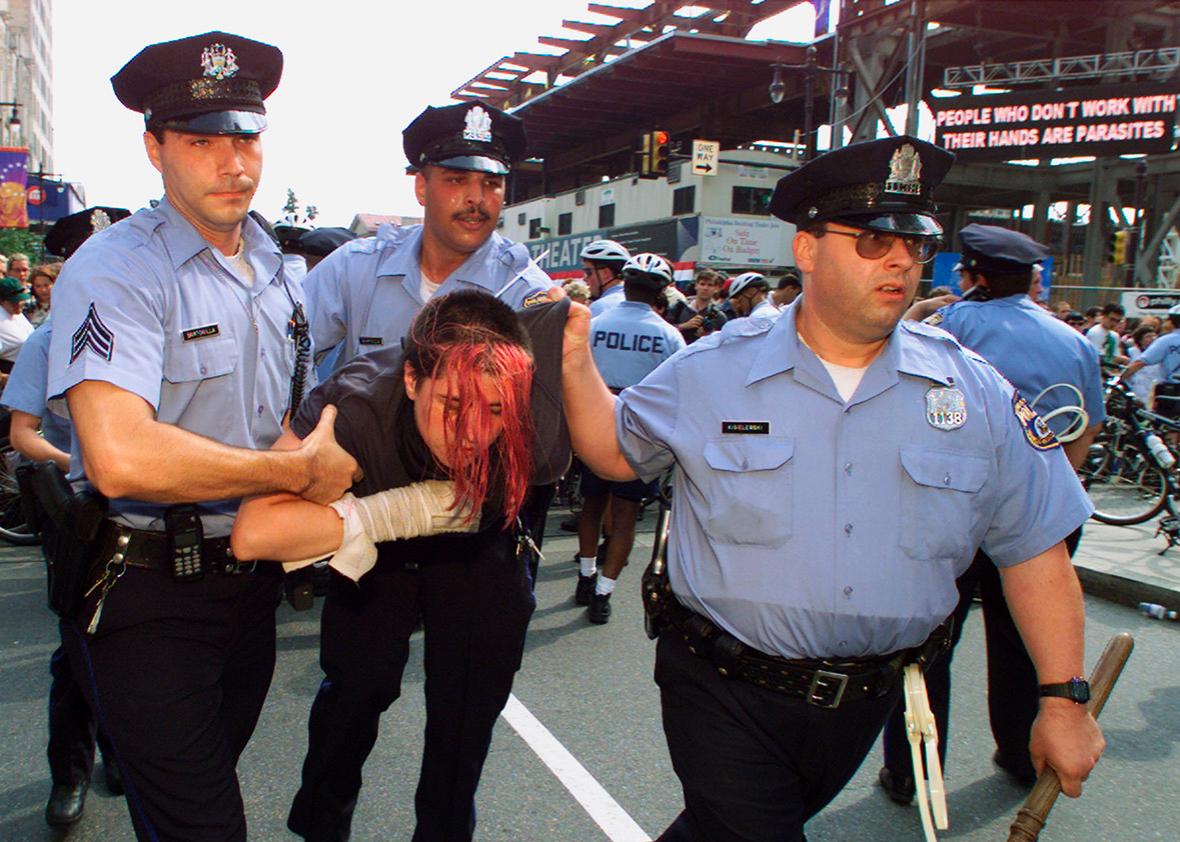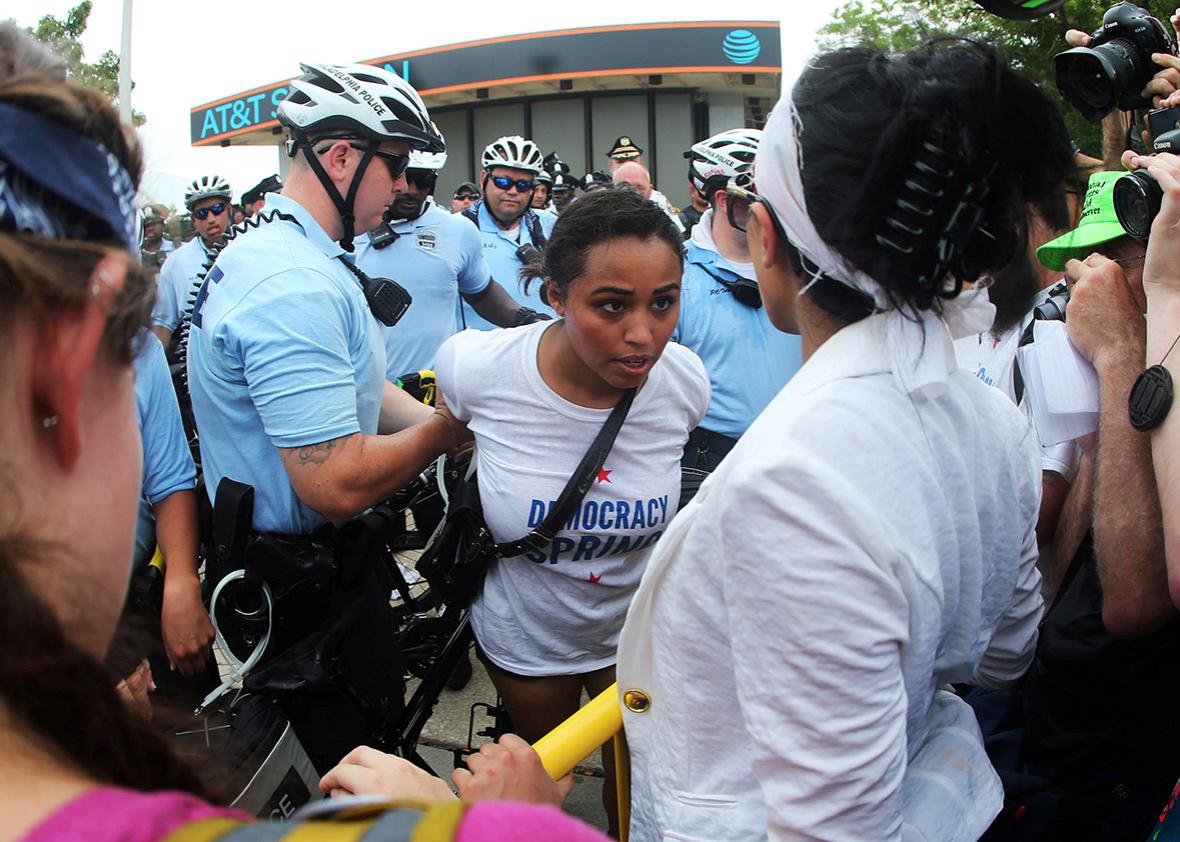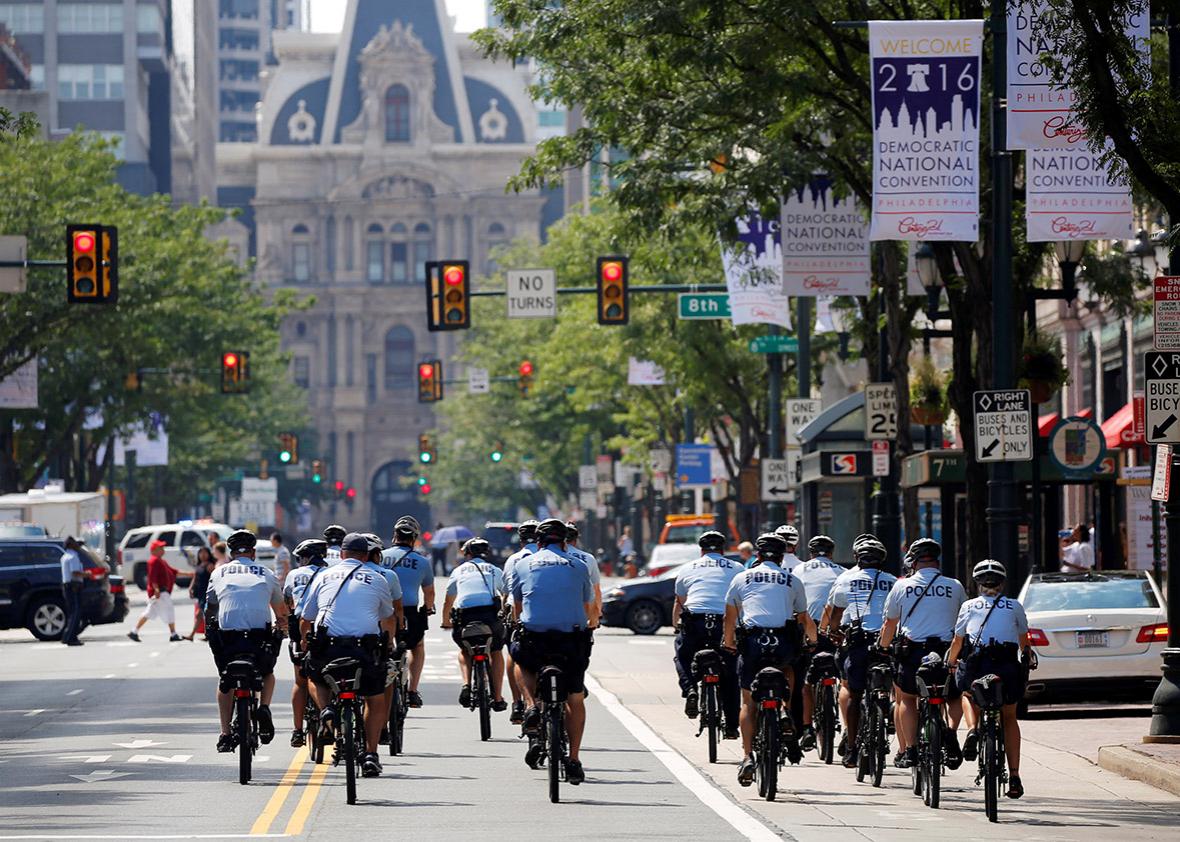The last time Philadelphia hosted a major political party’s national convention, it cost the city and its police department a lot in prestige and wasted time. The 2000 Republican National Convention resulted in more than 400 arrests, including a pre-emptive raid on a puppet-making warehouse in West Philadelphia. It later came out that state police officers had infiltrated the protest groups, even though the Philadelphia Police Department’s then-commissioner, John Timoney, had explicitly denied the use of such tactics. Activist leaders were identified, arrested, and held on astronomically high bails to keep them off the streets until George W. Bush left the city.
In the years that followed, hard-charging District Attorney Lynne Abraham prosecuted the RNC activists, but her lawyers lost again and again and again. The police even justified the repressive tactics by arguing—nine years after the end of the Cold War—that one protester group received funds from “the former Soviet-allied World Federation of Trade Unions.” It’s unknown how much the city lost in the resulting settlements, which are sealed, but it certainly ate up a lot of resource-starved prosecutors’ time. But such impunity is what protesters had come to expect from Philadelphia’s police, which had taken a hardline stance toward activism since the late 1960s.
The Democratic National Convention looks very different. Philadelphia isn’t much less rowdy than it was 16 years ago, with activists of every political stripe massing in the streets and crowds of protesters far thicker than they were in Cleveland for the RNC last week. But the Philadelphia Police Department that has greeted them is noticeably chiller, and the tactics it now uses to contain and manage protests have become subtler, less confrontational, and more media-savvy. As of Tuesday morning, no one has been jailed. On Monday evening, 54 protesters were detained, removed from the Wells Fargo Center, and then given code violation citations for $50 for disorderly conduct—and released. In another instance, police acquiesced to activists’ demand that the Mississippi state flag, which bears a Confederate battle emblem, be taken down from Philadelphia’s north-south arterial, Broad Street. (Every other other state flag is still hanging.)
Why the change? Because the shadows of the RNC and its litigious aftermath still loom over the department. “What came of it was a change of direction, and I say this as someone who had been representing protesters in Philly since Act Up,” says Larry Krasner, a civil rights attorney who represented many of the RNC protesters charged by the city. “Nobody likes four years of bad stories about them, editorials in the Inquirer about how the protesters were all framed. ‘This isn’t good, this isn’t what they had in mind. They all wanted to look like Clint Eastwood [during the RNC] and now they look like the Gestapo.’ ”

Reuters Photographer/Reuter
It remains to be seen if the lessons of the intervening 16 years will apply to the entire stretch of the DNC, but so far Philadelphia’s leaders seem to have visibly changed their ways. Mayor Jim Kenney is keenly aware of the potential for terrible optics in the context of the recent tensions around policing. In late June, he announced the city would not be purchasing an armored vehicle with $43 million in Department of Justice funds for new equipment. “We have no interest in riot gear or any kind of military vehicles,” the mayor promised at the National Press Club. However, the city still took out $5 million in so-called riot insurance against claims of excessive force, a common practice ahead of political conventions that’s meant to ease the sting if a city and its police are sued in the event’s wake.
In June, the Philadelphia City Council passed legislation making nuisance crimes like blocking a street or failing to disperse punishable with civil fines of $100 rather than criminal arrests. The move was talked up as a way to prepare for the DNC without stressing the criminal justice system and, in the words of one police representative, as a means to “build trust and legitimacy.” Police Commissioner Richard Ross also promised that his officers wouldn’t be decked out in riot gear during the DNC, although there could still be officers from federal law enforcement agencies who may not be bound by that promise.
“The bottom line is we have been very fluid in dealing with protesters and demonstrators the last probably 18 months or so,” said Ross at a security briefing for reporters before the DNC. “A blue uniform for police officers—that’s primarily what you’ll see. We will not be outfitted in anything special for the DNC. I mean, it’s going to be soft clothes. We are going to deal with this just as it’s a peaceful event.” At one point in the press conference, pressed to distinguish the police departments tactics at the DNC from the RNC in 2000, Ross hurriedly said, “We’re not looking to use those tactics, OK?”
The department has embraced this subtler kind of crowd control in many of the other protests that have occurred in recent years, from Occupy Philly to Black Lives Matter demonstrations to the local anti-austerity protests in reaction to the former Republican governor’s slashing of public education funds. As other cities saw police repressing protests with Stormtrooper gear, armored vehicles, tear gas, pepper spray, or widespread brutality, the Philadelphia Police Department managed affairs more quietly, for the most part. Traffic-disrupting marches have been allowed to continue for hours, largely guarded by bike police and the Civil Affairs Unit, which consists of plainclothes officers with orange armbands who are trained to negotiate and engage with protesters.
At a recent Black Lives Matter protest after the killings in Baton Rouge, Minnesota, and Dallas, Newsworks reporter Bobby Allyn reported seeing, from 7 to 10 feet away, an officer who “fell to the ground after being hit in the stomach.” It was impossible to see exactly what happened amid the scrum of people crushing together to force a path onto the highway, but the police later told Allyn that the officer had been struck. Regardless of whether the officer was harmed intentionally, it’s difficult to imagine the police in, say, Ferguson, Missouri, merely closing ranks and continuing to hold the line without making arrests or going on the offensive. But that’s what happened on the on-ramp to Roosevelt Boulevard that day.
This isn’t to say that relations between the police and protesters are all sweetness and light. Occupy Philly saw seven weeks of tolerance end on eviction night, when half of the remaining protesters were arrested en masse. They later won $200,000 from the city for civil rights violations. Another Occupy protester, Khadijah White, won a $30,000 settlement from the city after an officer broke her finger.
Veteran activist Jody Dodd, of the Up Against the Law legal collective, warns fellow activists that police response to protests can seem mercurial. They’re treating you civilly until, suddenly, they aren’t. To her, the incident on Roosevelt Boulevard sounds like an aberration (perhaps prompted by the especially heightened tensions that weekend). “I find that very surprising because the police do not hesitate to arrest people and charge them with felony assault if you touch them, if you bump up against them,” says Dodd. “I certainly don’t expect them to tolerate that kind of behavior at the DNC.”
But Dodd also doesn’t expect the police to return to tactics she saw at the RNC, when she witnessed the infiltration of protester groups and bail set as high as $1 million for some activist leaders. Since then, the protests she’s attended in Philly have been low-key in contrast to experiences in other cities. “I’ve went to many demonstrations in Philadelphia that were unpermitted events, where the police were fine as people marched for hours,” says Dodd. “The police didn’t arrest anyone, they just diverted traffic. Frankly, I’ve seen that happen more times than not in Philadelphia.”

Dominick Reuter/Reuters
For Krasner, the civil rights lawyer, it was the Occupy settlements, following the string of RNC settlements, that largely explain the city’s newly nonconfrontational tactics. The current state of police-and-protester relations stands in particular stark contrast to the department’s extremely aggressive attitude toward protesters for much of the latter half of the 20th century.
During the late 1960s and early 1970s, the police response to demonstrators was mass arrest, beatings, and evidence planting. Back then, the Civil Affairs Bureau was called the Civil Disobedience Unit, but it effectively served as the department Red Squad. Under Commissioner (and future mayor) Frank Rizzo, it was used to break up the Philadelphia branches of Students for a Democratic Society, the Student Non-Violent Coordinating Committee, and the Black Panthers. The unit even defied a judge’s orders and detained innocent protesters when President Richard Nixon, a key Rizzo ally, came to town to sign a revenue-sharing bill. During his tenures as commissioner and mayor, Rizzo amassed a large-enough arsenal that he bragged on live television that the department could “invade Cuba and win.” And perhaps no event came to define the Philadelphia Police Department’s brutality more than the 1985 firebombing of a row house occupied by the black militant group MOVE amid an armed standoff.
“There was the mentality those 30 or 40 years that we [the police] are going to control [the streets],” says David Rudovsky, who has been a civil rights lawyer in Philadelphia since 1967. “We have a long history of suppressing speech, just basic free speech. …[But] since 2000, I think there have been some incidents that were questionable, but overall I think the Philadelphia have been less confrontational than other places.”
In 2002 Timoney, who led the department during the RNC, left for Miami (where he subsequently led the tear gas–soaked suppression of fair-trade protests). In 2010, Lynne Abraham, the district attorney who led the prosecution of the protesters, retired. The men who replaced them, Commissioner Charles Ramsey and District Attorney Seth Williams, will never be confused for left-wing icons, but they led Philadelphia’s law enforcement apparatus in a different direction when confronted with this decade’s unrest.
In an interview last year, former police commissioner Charles Ramsey—who oversaw a repressive and illegal response to protests in Washington, D.C.’s Pershing Park in 2002, when he led that city’s police force—denounced the mass arrest tactics of his old department. “We screwed that up,” he told the New York Times, referring to Pershing Park. “It was wrong.” Then he argued that his handling of Occupy Philadelphia proved his progressive evolution.
Although Dodd believes that caution should be the rule when protesters interact with law enforcement, she agrees that the Philadelphia police acted with relative restraint during the Occupy movement. She is unaware of any significant police infiltration of the encampments or people being framed for the kind of specious reasons used during the RNC. (The police alleged, without evidence, the planning of attacks with acid-filled balloons). During the few days of the RNC in 2000, more than 400 people were arrested, while she estimates that roughly 100 were arrested during the seven weeks of the Occupy encampment—and many of those during planned actions like bank occupations and street sit-ins.
Even when the hammer did come down on the final night of Occupy, Ramsey’s assertion that he’d learned from his mistakes is partially borne out by the amount the city ended up owing in damages. After the crackdown in Pershing Park, D.C. ultimately ended up paying $24 million in “damages and other costs,” according to the New York Times, while the eviction night outside Philadelphia’s City Hall resulted in $200,000. There have been no mass arrests of Black Lives Matter activists in Philadelphia thus far.
During the DNC, of course, Philadelphia police wouldn’t the only ones on the ground. Federal, state, and other local jurisdictions would be represented as well.
“I think if it was ultimately just the Philadelphia police department’s call they would probably let people protest and not lock them up en masse,” says Dodd, who worries that federal law enforcement agencies will be more aggressive than the local police. “Whenever the police don riot gear, line up, and start behaving in an aggressive manner that is when things escalate [something she’s never seen Philly police do]. If they are smart they will let people march like they have many, many, many times over the last 16 years, without arrest and without incident.”
